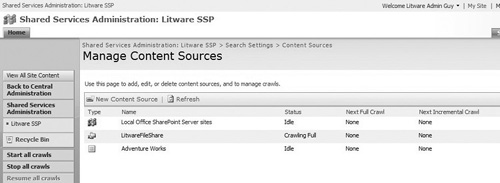Search Examples
Now that you have a general idea of how MOSS search works, let’s put it together into a few examples. In this section, we’ll combine several search techniques to build powerful business solutions that require no code.
Limit Search To File Server
In this example, you’ll build a solution that allows users to search content that currently exists on the file server. In this business scenario, currently all archived business documents are being stored on the file server. These documents are moved to the file server and remain there until they can be deleted per the corporate document management strategy. On occasion, users need to reference these documents, and they want to search through these documents from the corporate search center.
To provide the functionality requested by the users, you’ll implement the following search techniques.
Create a content source for the file server content.
Create a custom search scope restricted to the file server content.
Add a custom tab to the search center where the Web Parts will be restricted to the new custom search scope.
Exercise: Create a New Content Source
|
In this exercise, you’ll create a content source for the data currently stored on the file server. This allows users to search the file server data from the SharePoint search center. To get started, you’ll need to access the SSP from the Central Admin site.
|
Exercise: Create a New Scope
|
Now that a new content source has been created, you can create a new search scope that allows users to limit their search to only content defined by the search scope. In this example, you’ll be creating a global search scope that can be used on any site collection in the farm.
|
Exercise: Adding a Tab to the Search Center
|
The Search Center with Tabs template allows you to customize the tabs to meet your needs. This example shows how to use the template to create a new tab to search a specific scope. This allows users to search only in one scope when they select that tab.
|


















